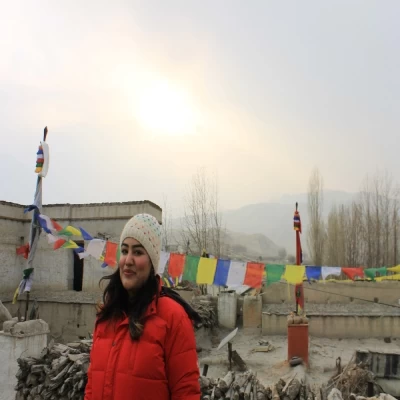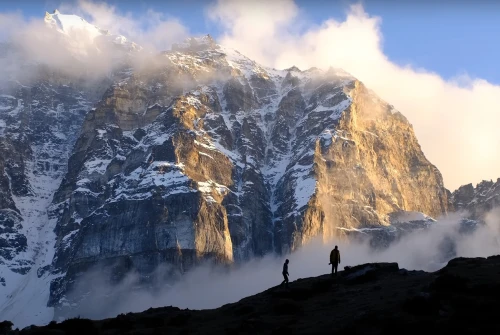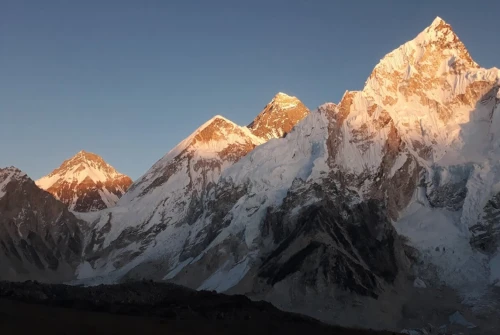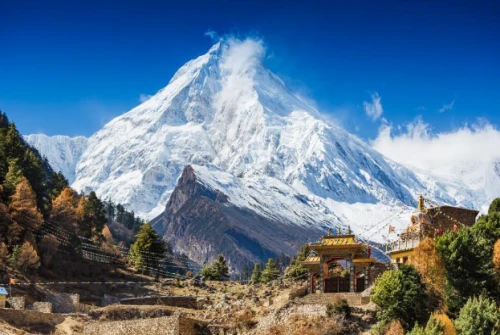Introduction:
If you wish to travel into the untouched Himalayan wilderness, cross high passes, trek through deep valleys, and experience raw adventure in Nepal, this trek might just be perfect for you. Let’s break down the difficulty level, physical requirements, and challenges you need to prepare for before heading to this trek.
How Difficult is the Kanchenjunga Base Camp Trek?
The difficulty of the trek will surely depend on how well-experienced the trekker you are. Other than that it will vary depending on some of the factors below.
1. Distance & Duration – How Long Does It Take?
Kanchenjunga Base Camp Trek is not for the faint-hearted. Unlike other more popular trekking routes in Nepal, such as Everest Base Camp or Annapurna Circuit, Kanchenjunga is a remote and demanding journey that requires almost 3 weeks of commitment. Covering approximately 220 km (137 miles), the trek takes anywhere from 17 to 25 days to complete, depending on the chosen itinerary, pace, weather conditions, and acclimatization needs.
Let’s explore some of the factors that can affect the duration of the Kanchenjunga Base Camp Trek.
Trekking Experience & Fitness Level – Beginners or those who have not experienced high-altitude treks may need additional rest days to recover, while experienced trekkers may complete the journey faster.
Weather Conditions – The best time for the Kanchenjunga Base Camp trek is spring (March-May) and autumn (September-November) when trails are more stable. If you processed for this trek in harsh winter or monsoons you will face problems in navigating roads due to snow blockages or landslides respectively. Bot the cases will end of increasing the trekking days.
Acclimatization Needs – Kanchenjunga is one of the highest-altitude treks. You will need good acclimatization days during this trek. Depending on your body and how easily you can adapt to the elevation you will need at least 2-3 acclimatization days to prevent altitude sickness.
Route Selection – Some itineraries cover both North and South Base Camps, extending the duration. Others may take alternative paths, impacting the overall trek length. So, the duration of your trek will surely depend on the itinerary you will choose.
2. Terrain Challenges – What to Expect?
The Kanchenjunga trek will take you on steep ascents, rocky trails, high mountain passes, and isolated villages spread across the eastern Himalayas. Unlike well-trodden paths in Nepal, this trek has fewer teahouses, meaning longer hiking hours and sometimes even camping in remote areas.
You can make up your mind to walk on long, tiring climbs, knee-crushing descents.
rocky and uneven trails, slippery sections, moraines, and landslide-prone areas that are quite challenging to cross. This is not a beginner-friendly trek. Even experienced trekkers will find it demanding at times.
3. Altitude Sickness Risk – How High Do You Go?
Kanchenjunga Base Camp Trek is a high-altitude adventure, pushing trekkers into extreme elevations where oxygen levels drop significantly. The risk of Altitude Sickness (Acute Mountain Sickness - AMS) is a major concern, making acclimatization and preparation essential for a safe and successful trek
The trek takes you to some of the highest points in Nepal’s Himalayas:
North Base Camp (Pangpema): 5,143m (16,873ft)
South Base Camp (Ramche): 4,610m (15,124ft)
Both camps exceed 4,500m, a threshold where many trekkers start experiencing altitude-related symptoms. The high elevation, coupled with the remoteness of the trek, makes proper acclimatization and a slow ascent crucial for preventing AMS.
Understanding Altitude Sickness and Its Symptoms
Altitude sickness occurs when your body struggles to adapt to reduced oxygen levels at high elevations. Common symptoms include:
Headaches (ranging from mild to severe)
Nausea and vomiting
Dizziness and confusion
Loss of appetite
Shortness of breath even at rest
Difficulty sleeping (insomnia at altitude)
If the symptoms are mild it's fine but if the symptoms are severe please make sure to inform your guide and consult with him. If left untreated, AMS can escalate into High Altitude Pulmonary Edema (HAPE) or High Altitude Cerebral Edema (HACE), both of which are life-threatening conditions requiring immediate descent.
How to Minimize the Risk of Altitude Sickness
Here are some of the triple we recommend you follow to avoid the risk of Altitude sickness.
Follow a Gradual Ascent – The key to avoiding AMS is a slow and steady approach. Experts recommend not ascending more than 300-500m per day above 3,000m.
Acclimatization Days – Take at least 2-3 rest days at key points (e.g., Ghunsa or Lhonak) to allow your body to adjust.
Stay Hydrated – Dehydration worsens altitude sickness, so drink 3-4 liters of water daily. It's not necessarily important to drink only water, you can just push yourself to drink liquid items more like soup and tea.
Avoid Alcohol and Sleeping Pills – Do not involve drinking Alcohol, cigarettes, or sleeping tablets for sleeping because these can slow breathing and worsen oxygen absorption.
Consider Diamox (Acetazolamide) – Diamox helps with acclimatization, but consult your doctor before taking it. Also, inform and consult with guides.
Listen to Your Body – If symptoms persist, consult with your guide and descend immediately. Ignoring AMS can be fatal.
Should You Attempt Kanchenjunga Without Prior High-Altitude Trekking?
If you haven’t trekked above 4,500m, it’s wise to build experience with Everest Base Camp (5,364m) or Annapurna Circuit (5,416m) first. These routes have better infrastructure, emergency facilities, and gradual altitude gain, making them excellent preparation for Kanchenjunga’s extreme heights.
Kanchenjunga Base Camp is a rewarding yet demanding trek, and altitude sickness should never be underestimated. With the right preparation, slow ascent, and awareness of AMS symptoms, you can safely enjoy the breathtaking landscapes of the world’s third-highest peak.
4. Daily Walking Hours – How Much Do You Walk?
Kanchenjunga Base Camp Trek is not just about distance or altitude—it’s also about endurance. Unlike more developed trekking routes, this remote Himalayan adventure demands long daily trekking hours, often through rugged and challenging terrain.
How Many Hours Do You Walk Per Day?
Average Trekking Time: 6-8 hours per day
Longer Days: Some sections may require up to 10 hours of trekking, especially in high-altitude areas or when crossing difficult passes.
Minimal Rest Stops: Since the region is less developed, expect longer stretches without access to teahouses or lodges.
On easier days, you may cover 10-12 km in 6 hours, but on steeper or high-altitude sections, even 8 km can take 8+ hours due to the demanding trails and lack of oxygen at higher elevations.
What Makes the Trekking Hours So Challenging?
Remote Trails Without Road Access
The Kanchenjunga region is one of the most isolated trekking areas in Nepal. There are no road connections once you start the trek, which means no easy way out if exhaustion, altitude sickness, or injury occurs. You must rely entirely on your endurance, guidance, and group.Unpredictable Weather Conditions
Weather in the Himalayas can shift dramatically, adding hours to your trek. Heavy rainfall, snowfall, or high winds can slow progress and make trails slippery and dangerous.Tough Terrain and River Crossings
The trek involves steep ascents, descents, glacier crossings, and narrow ridges. In some sections, paths may be affected by landslides or require careful navigation across rocky terrain.Few Rescue or Medical Facilities
Unlike Everest or Annapurna treks, where helicopter rescues are common, Kanchenjunga has very limited evacuation options. If an emergency occurs, the only way to get help is by trekking to the nearest village—adding to the challenge of long trekking hours.
Do You Need Physical and Mental Endurance?
Absolutely! The Kanchenjunga trek is not just a physical test but also a mental challenge. Long trekking hours, harsh conditions, and fatigue can take a toll. Here’s how to prepare:
Train for Stamina: Hike with a loaded backpack, increasing distance and elevation over time.
Strength Training: Focus on leg strength, endurance, and core stability to handle steep climbs.
Mental Toughness: Staying motivated is key for long, isolated days with limited comfort.
Practice Multi-Day Treks: Experience with multi-day hikes at high altitudes helps condition your body for continuous effort.
Kanchenjunga is one of the toughest trekking routes in Nepal, and the long daily walking hours make it even more challenging. However, with the right mindset, training, and preparation, completing this trek is an enriching experience that few adventurers can claim.
Who Can and Can’t Do This Trek?
Kanchenjunga Base Camp Trek is one of the most demanding treks in Nepal, requiring high-altitude experience, endurance, and mental resilience. This is not a trek for everyone—it is designed for serious adventurers seeking a raw and challenging Himalayan experience.
Who Is This Trek Ideal For?
Experienced Trekkers – If you have completed treks like Everest Base Camp (5,364m), Annapurna Circuit (5,416m), or Manaslu Circuit (5,106m), you will be better prepared for the high altitude and physical demands of Kanchenjunga.
Fit Hikers Comfortable With Long Walking Hours – You need the stamina to trek 6-10 hours daily for nearly three weeks. If you can comfortably hike for multiple days at 4,000m+ elevations with a backpack, you have a good chance of succeeding.
Adventure Seekers Who Prefer Remote Treks – If you enjoy off-the-beaten-path adventures away from crowds, Kanchenjunga is perfect. Unlike Everest or Annapurna, this trek sees very few trekkers, offering raw nature, isolated villages, and untamed wilderness.
Those Comfortable With Limited Facilities – Since Kanchenjunga is less commercialized, accommodation is basic. Trekkers must adapt to minimal amenities, long days without hot showers, and possible camping in some sections.
Who Should Avoid This Trek?
Complete Beginners – If you have never done a multi-day trek, Kanchenjunga is NOT the place to start. The extreme altitude, remoteness, and tough terrain make it one of Nepal’s hardest treks. Start with Everest Base Camp or Annapurna Base Camp to build experience.
People With Heart or Lung Conditions – The trek reaches over 5,000m, where oxygen levels are significantly lower. If you have heart disease, severe asthma, high blood pressure, or respiratory problems, this trek can be life-threatening. A medical check-up is essential before considering this trek.
Anyone Who Cannot Commit to a 3-Week Trek – Kanchenjunga demands 17-25 days, including travel, acclimatization, and trekking. If you cannot take this much time off or prefer shorter treks, consider alternatives like the Everest Three Passes Trek or Langtang Valley Trek.
How to Train for Kanchenjunga Base Camp Trek?
Kanchenjunga Base Camp Trek is one of the toughest trekking adventures in Nepal, demanding a high level of physical fitness, endurance, and mental toughness. Proper training is essential to ensure you can handle the long trekking hours, steep ascents, and high altitudes without risking exhaustion or altitude sickness.
1. Build Cardiovascular Endurance
The trek requires 6-10 hours of walking daily at high altitudes, where oxygen levels are significantly lower. Strong cardiovascular fitness is crucial for maintaining energy levels and stamina.
Recommended Training:
Running or Jogging: Helps improve lung capacity and endurance.
Cycling: Strengthens the legs while boosting cardiovascular health.
Swimming: A full-body workout that enhances breathing efficiency.
Stair Climbing: Simulates the steep ascents of the trek.
HIIT Workouts: High-intensity interval training improves overall stamina.
Training Timeline: Start at least 3-6 months before the trek and aim for 4-5 cardio sessions per week.
2. Strength Training for Tough Terrain
Kanchenjunga’s trails are filled with steep inclines, rocky paths, and high-altitude sections that require strong legs and core muscles.
Recommended Exercises:
Squats & Lunges: Strengthen the quadriceps and glutes for uphill climbs.
Step-Ups: Mimic trekking movements by stepping onto a high platform with a weighted backpack.
Deadlifts & Core Workouts: Help improve balance and prevent injuries.
Focus on leg, core, and back strength to ensure you can handle both the inclines and long walking hours.
3. Trekking Preparation – Simulate Real Conditions
Nothing prepares you better than actual trekking! Get used to walking long hours with a backpack to simulate the real experience.
How to Train:
Practice Hikes: Start with short treks, then progress to longer hikes with elevation gain.
Wear Your Trekking Gear: Train with the boots, backpack, and clothing you’ll use on the trek.
Train With a Weighted Backpack (8-10kg): This helps build endurance and prepares your body for carrying supplies during the trek.
Should You Hire a Guide for This Trek?
Yes! A guide is MANDATORY. Since Kanchenjunga is a restricted area, solo trekking is not allowed without a licensed guide.
Why Hiring a Guide is Essential:
Navigation & Safety: Kanchenjunga’s trails are remote and poorly marked. A guide prevents getting lost.
Altitude Management: Guides monitor altitude sickness symptoms and help make informed decisions.
Logistics & Permits: They handle restricted area permits and organize accommodation.
Guide Cost: $25-35 per day
Porter Cost: $20-25 per day (recommended to carry heavy backpacks)
Final: So, is this Trek for You?
Before committing, ask yourself, Can I trek 6-8 hours a day for 3 weeks? Am I comfortable trekking above 5,000m? Do I have prior high-altitude trekking experience?
If you answered YES, Kanchenjunga is the ultimate adventure for you! Prepare well, train hard, and embrace the challenge—it will be one of the most rewarding treks of your life.
If you answered NO, start with an easier trek like Everest Base Camp or Annapurna Circuit to gain experience before tackling Kanchenjunga.
Kanchenjunga Base Camp Trek is a raw, thrilling, and intense journey—perfect for experienced trekkers seeking an off-the-beaten-path Himalayan adventure. If you’re ready, this trek will test your limits and reward you with some of the most breathtaking landscapes on Earth.
So, are you up for the challenge? If yes All Nepal Hiking has created three itineraries for this trek that have different trekking days. They are listed below:




